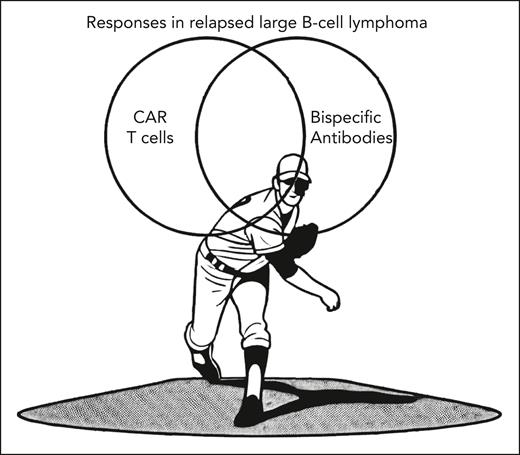In this issue of Blood, Topp et al show that odronextamab, a CD20×CD3 bispecific antibody, is a promising treatment for relapsed or refractory (R/R) large B-cell lymphoma (LBCL), including in patients failed by chimeric antigen receptor (CAR) T-cell therapy.1
Imagine you are holding a baseball bat and facing an all-star pitcher. You already have 2 strikes against you, and the pitcher is winding up trying to strike you out. Patients with LBCL that did not achieve a durable response to chemoimmunotherapy and CAR T-cell therapy know the feeling. What is the optimal strategy to hit a home run when treating LBCL that already has 2 strikes?
Since their 2017 approval, CAR T cells have proven to be curative in some patients with relapsed lymphomas who previously had limited options.2-4 More recently, axicabtagene ciloleucel and lisocabtagene maraleucel have demonstrated superiority over chemotherapy and autologous transplant in randomized phase 3 studies, resulting in improved overall survival.5,6 Consequently, in settings where second-line CAR T-cell therapy is available, it is now considered the preferred standard of care.7 Unfortunately, nearly half of patients do not achieve durable responses, leaving an urgent unmet need, often due to loss of CD19 expression.
Bispecific antibodies, which recruit T cells to attack B cells by binding CD3 and CD20, represent a novel class of immune therapies. Glofitamab and epcoritamab are approved for R/R diffuse LBCL (DLBCL), with other agents in development.8,9 Odronextamab, an Fc-silenced, human CD20×CD3 bispecific antibody, has shown an overall response rate of 53% in patients with R/R DLBCL naive to prior CAR T-cell therapy.10
ELM-1 is a phase 1, single-arm, multicenter study that enrolled adults with R/R CD20+ DLBCL. Topp et al present an expansion cohort specifically focused on patients with prior CAR T-cell therapy. Patients received odronextamab intravenously on 2 dosing schedules. Initially, doses included 1 mg on day 1 and 20 mg on day 8, later modified to a “split dosing” given over 2 consecutive days each week of 0.7 mg, 4 mg, and 20 mg. Subsequent dosing was 160-mg weekly for cycles 2 to 4, followed by 320 mg every other week for cycles 5 to 10. For patients with a complete response, treatment continued monthly until disease progression or unacceptable toxicity. The primary end point was the overall response rate by central review, with secondary end points including safety and survival metrics. Exploratory immune profiling was also planned.
The trial enrolled 60 heavily pretreated patients (median of 3 prior lines), with over 70% being refractory to CAR T-cell therapy. In this difficult-to-treat population, 48.3% of patients responded to odronextamab, with 31.7% achieving complete response. Response rates were consistent across various CAR T products and high-risk features, but lower in patients without a response to or progression soon after prior CAR T-cell therapy (overall response rate: 20%-27%). The median duration of response was 14.8 months, and median progression-free survival was 4.8 months. At 12 months, 26.5% of patients were progression-free, including 77% of those with complete response.
Immune-related toxicities, including cytokine release syndrome (CRS), were common but manageable. CRS occurred in 48.3% of patients, with 25% experiencing only grade 1 (fever) and no grade ≥3 events. No cases of immune effector cell-associated neurotoxicity syndrome were reported. Infections were frequent, affecting 50% of patients, with 20% experiencing grade ≥3 infections (typically requiring IV antibiotics).
Exploratory analyses revealed that nearly half of the patients with baseline available tissue had loss of CD19 expression. Interestingly, CD20 expression did not correlate with response to odronextamab. Peripheral blood analysis showed transient decreases in CD8+ and CD4+ T-cell counts and increases in PD1+ T cells after step-up dosing, suggesting initial T-cell activation and recruitment to the tumor microenvironment. Improvements in T-cell fitness over time were observed but are confounded by survivor bias.
This study is significant for several reasons. First, previous analyses of patients after CAR T-cell treatment were limited by small sample sizes as subsets of trials, not dedicated cohorts. Second, as CAR T-cell therapy is increasingly used in earlier lines, understanding optimal treatments for those who are failed by CAR T-cell therapy is critical. Third, this study partly addresses the emerging question: do resistance mechanisms to bispecific antibodies and CAR T-cells overlap or have important differences (see figure)? It appears that some patients who do not benefit from CAR T-cell therapy may benefit from odronextamab.
Venn diagram of lymphomas treated with CAR T-cell and bispecific therapies, demonstrating both overlapping and distinct responses.
Venn diagram of lymphomas treated with CAR T-cell and bispecific therapies, demonstrating both overlapping and distinct responses.
Odronextamab demonstrated notable efficacy in this difficult-to-treat population. However, limitations include the lack of a comparator arm to evaluate how odronextamab fares against other treatment options such as antibody-drug conjugates, allogeneic CAR T cells, bispecific antibodies combined with costimulatory molecules, small molecule inhibitors, or conventional chemotherapy. The schedule of odronextamab, twice weekly during the first cycle, a total of 27 intended infusions over 10 cycles, and indefinite therapy for responders, is cumbersome compared with other agents in clinical development for this disease indication. Additionally, patients with poor responses to CAR T-cell therapy, the biggest unmet need, also derived less benefit from odronextamab.
In conclusion, odronextamab is a solid base hit in patients who already have 2 strikes, progressive LBCL after chemoimmunotherapy and CAR T-cell therapy, with almost half of patients responding and a median response duration of over 14 months. Although future studies are warranted to further optimize outcomes, this study establishes odronextamab as a promising option for a population with limited alternatives.
Conflict-of-interest disclosure: J.W. declares funding from AbbVie, Allogene, ADC Therapeutics, AstraZeneca, Bristol Myers Squibb, Genentech, GenMab, Janssen, Kite/Gilead, Morphosys/Incyte, Novartis, Nurix, Pfizer, and Regeneron.


This feature is available to Subscribers Only
Sign In or Create an Account Close Modal